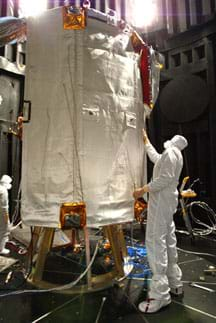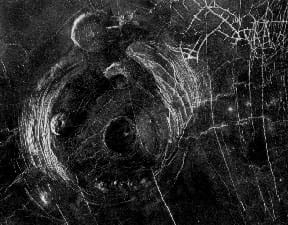We are going to learn about all eight planets, but today we are just going to focus on the first two – Mercury and Venus. Did you know that Mercury is the second smallest planet in our solar system? It travels faster around the Sun than any other planet; it takes only 88 days to rotate around the Sun. Mercury looks a lot like Earth's Moon. It has cliffs and valleys and craters. What do you think the Sun looks like from Mercury? Well, it looks two to three times larger than how we see it from Earth. Depending where you are on Mercury, you would see the Sun move in a strange pattern during the day. The Sun would rise, then seem to set (appearing to grow smaller), and then start to rise again. The same thing happens in reverse when the Sun sets. This is due to Mercury's egg-shaped orbit and the number of times it rotates in a given year.
Venus is the second planet from the Sun. It is also the second brightest object in our night sky, besides our Moon. If you were to sit on the surface of Venus, it would look like a cloudy, drizzly day. Scientists think that Venus once had water, but that it has long since evaporated; now it rains sulfuric acid. The temperature on Venus is in excess of 900 oF (480oC) during the day, because the clouds trap in heat from the Sun instead of releasing it to the atmosphere. In fact, it is hotter on the surface of Venus than Mercury, because Mercury does not have the thick clouds. Venus's atmosphere is thick and poisonous, with strong winds and lightening. The atmospheric pressure on the surface would crush metal spacecraft in a few hours. Venus is not a friendly place for humans to visit. One more interesting thing about Venus is that it spins in the opposite direction than the Earth spins, so for us it would look like the Sun moves backwards across the sky.
We know that Mercury and Venus are the first and second planets nearest the Sun, and we know that they have some characteristics that are pretty different from Earth, but who can tell me how we find out about the planets? Since Venus is so hot on its surface, it is way too dangerous to send people there. So, how do we know what it is like? That's right; we have to design something to remotely investigate the planet for us. From Earth, we can observe the planets through telescopes. However, to get more details and measurements of temperature and atmosphere and surface conditions, we must send a spacecraft to the planet. Who do you think gets to design systems to tell us about the planets? That's right – engineers do! Engineers design special space equipment and spacecraft to help us learn more about outer space and the planets.
Mercury
Mercury is the closest planet to the Sun and the second smallest of our planets. Mercury was named for the Roman messenger of the gods, because it seemed to move faster than any of the other planets in the sky. In fact, Mercury travels around the Sun every 88 days.
Engineers and scientists built the Mariner 10 spacecraft and it passed within 12,000 miles from the surface of Mercury in 1974. Mariner 10 relayed detailed information about Mercury's surface conditions, such as temperature, to the Earth. Mariner 10 was only able to view part of the planet. A spacecraft named Messenger was launched in 2004 to fly by Mercury three times, with the mission to map the entire planet and study its shape, interior and magnetic field.

Mercury's surface has been hit many times by meteorites; thus, it resembles our Moon. Mercury does not have plate tectonics, but has lava flows. According to NASA, ice caps appear to exist on the North and South Poles, and deep inside of craters. Scientists believe that the ice can exist because the areas where it always remain in shadow. Mercury is thought to have a dense iron core and a thin mantle and crust. The core's radius is approximately 1,800-1,900 km, while its crust and mantle are only about 500-600 km thick.
Mercury's surface is a lot like the Earth's Moon: it has a barely detectible atmosphere, no known life, and craters of all sizes. Unlike the Moon, the temperature ranges from 800 oF (430 oC) in the day to 280 oF (140 oC) at night. If you were to stand on Mercury, the Sun would appear two to three times larger than it looks to us when standing on Earth.
Venus
Venus is the second planet from the Sun and its size is similar to the Earth. Venus was named after the Roman goddess of love. While Venus is almost the same size of Earth, it rotates retrograde. So, on Venus, the Sun rises in the west and sets in the east. During its orbit of the Sun, it comes within 26 million miles (42 million km) of the Earth.
To further explore the conditions on Venus, over the years engineers have designed a few probes to enter its atmosphere. But they do not last long, as surface conditions are extremely hostile! A thick atmosphere of carbon dioxide encloses Venus, and the atmospheric pressure is 90 times that of the Earth's. It rains sulfuric acid. Daytime temperatures reach up to 900 oF (480 oC) year round. Probes that have landed on Venus have not survived more than a few hours before being destroyed by the incredibly high temperatures. It is a greenhouse gone wild! These thick atmospheric clouds also reflect sunlight, making Venus often the brightest planet in our sky.

Venus's gray rocks appear tinted yellow from the Sun shining through the atmosphere. The many volcanoes on Venus vary in size from large mountains to small domes. Volcanic eruptions shape the surface of Venus. With very little surface wind and no water (so unlike the Earth), these factors play little part in erosion. But, the winds at high elevations are stronger, and are known as super-rotation; they circulate Venus every four days. Like Earth, Venus has atmospheric circulation patterns between the equatorial and polar areas. Venus shows no evidence of plate tectonics, which on Earth are an important way for planetary heat release. Instead, large, circular patterns called coronae form on the surface, causing surface warps as they release hot material from below the surface.

No comments:
Post a Comment